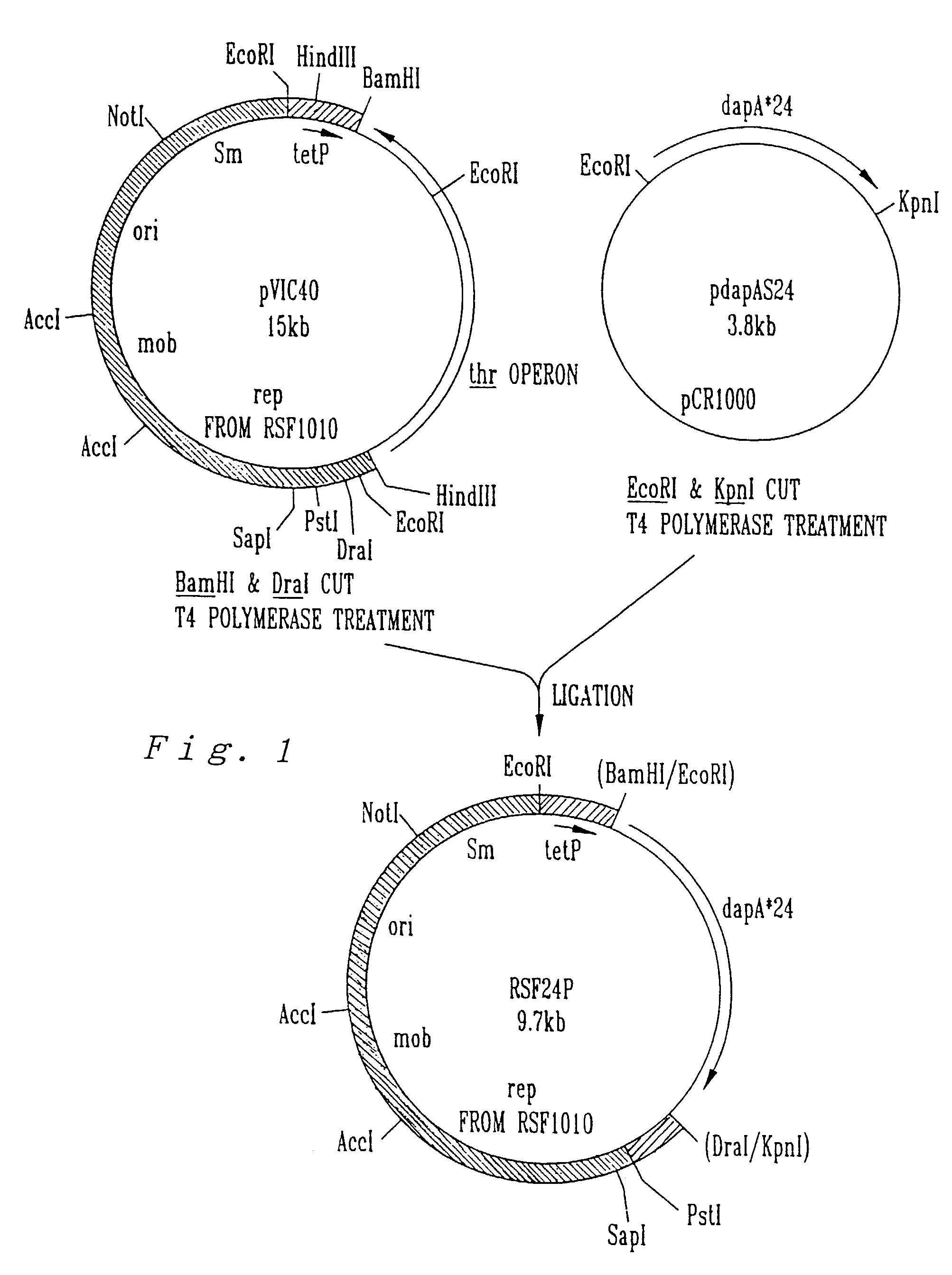Methods for producing L-amino acids
a technology of l-amino acids and microorganisms, which is applied in the direction of microorganisms, biochemical equipment and processes, bacteria based processes, etc., can solve the problem that no method has been known to produce l-amino acids from methane as a carbon source by utilizing microorganisms, and achieves the effect of efficient production of l-amino acids and inexpensive raw materials
- Summary
- Abstract
- Description
- Claims
- Application Information
AI Technical Summary
Benefits of technology
Problems solved by technology
Method used
Image
Examples
example 1
Acquisition of L-amino Acid Producing Strain Derived from Methylomonas albus
(1) Acquisition of L-lysine Resistant Strain of Methylomonas albus
[0080]The NCIMB 11123 strain, a wild type strain of Methylomonas albus, was cultured at 30° C. for 48 hours in NMS medium mentioned below in the presense of methane, and the obtained bacterial cells were subjected to mutagenesis treatment with NTG in a conventional manner (NTG 50 μg / ml, 30° C., 30 minutes). The NCIMB 11123 strain can be obtained from The National Collections of Industrial and Marine Bacteria Ltd. (Address: NCIMB Lts., Torry Research Station 135 Abbey Road, Aberdeen AB98DG, United Kingdom).
[Composition of NMS Medium]
[0081]Potassium nitrate: 1 g / L, magnesium sulfate: 1 g / L, calcium chloride: 0.2 g / L, iron-EDTA: 3.8 mg / L, sodium molybdate: 0.26 mg / L, copper sulfate: 0.2 mg / L, iron sulfate: 0.5 mg / L, zinc sulfate: 0.4 mg / L boric acid: 0.015 mg / L, cobalt chloride: 0.05 mg / L, sodium EDTA: 0.25 mg / L, manganese chloride: 0.02 mg / L, ...
example 2
Production of L-amino Acids Using L-lysine Resistant Strain of Methylomonas albus
[0087]A wild type strain and the No.107-4 strain of Methylomonas albus were each inoculated in an amount of 2 platinum loops to NMS medium containing 1.5% of agar, and cultured at 30° C. for 7 days in the presence of 50% methane. The whole amount of the obtained cells were inoculated to 500 ml of AMS medium supplemented with 4 μM CuSO4 contained in a 1-L volume fermentation vessel (produced by Biott), and cultured at 30° C. under the conditions of stirring at 400 rpm or above, dissolved oxygen concentration of not less than 5 ppm, with supply of air and methane at 200 ml / minute and 100 ml / minute, respectively. AMS medium is a medium that is identical to NMS medium except that KNO3 is replaced with an equivalent amount of NH4Cl in terms of nitrogen. During the culture, pH of the medium was automatically controlled to be 6.5 with ammonia gas. 10 ml of 1 mM CuSOs4 was added 39 hours and 65 hours after the...
example 3
Production of L-lysine Utilizing AEC Resistant Strain of Methylomonas albus
[0090]A wild type strain of Methylomonas albus and the AEC resistant strain No. 135-3-63 were inoculated each in an amount of one colony to NMS medium containing 1.5% of agar, and cultured at 30° C. for 7 days in the presence of 50% methane. 1 / 10 Platinum loop of each of the obtained seed culture was inoculated to 3 ml of NMS medium in a 30-ml volume pressure-proof test tube and 15 ml of methane was injected and cultured at 30° C. for 72 hours with shaking. After the culture was completed, the cells were removed by centrifugation and amino acids contained in the obtained culture supernatant was analyzed by an amino acid analyzer. The results are shown in Table 3. While L-Lys was not detected in the culture supernatant of the wild type strain, 0.86 mg / L of L-Lys was accumulated by the No.135-3-63 strain.
[0091]
TABLE 3L-lysine accumulation by AEC resistant strainderived from Methylomonas albusStrainL-Lys (mg / L)...
PUM
| Property | Measurement | Unit |
|---|---|---|
| temperature | aaaaa | aaaaa |
| volume | aaaaa | aaaaa |
| volume | aaaaa | aaaaa |
Abstract
Description
Claims
Application Information
 Login to View More
Login to View More - R&D
- Intellectual Property
- Life Sciences
- Materials
- Tech Scout
- Unparalleled Data Quality
- Higher Quality Content
- 60% Fewer Hallucinations
Browse by: Latest US Patents, China's latest patents, Technical Efficacy Thesaurus, Application Domain, Technology Topic, Popular Technical Reports.
© 2025 PatSnap. All rights reserved.Legal|Privacy policy|Modern Slavery Act Transparency Statement|Sitemap|About US| Contact US: help@patsnap.com

